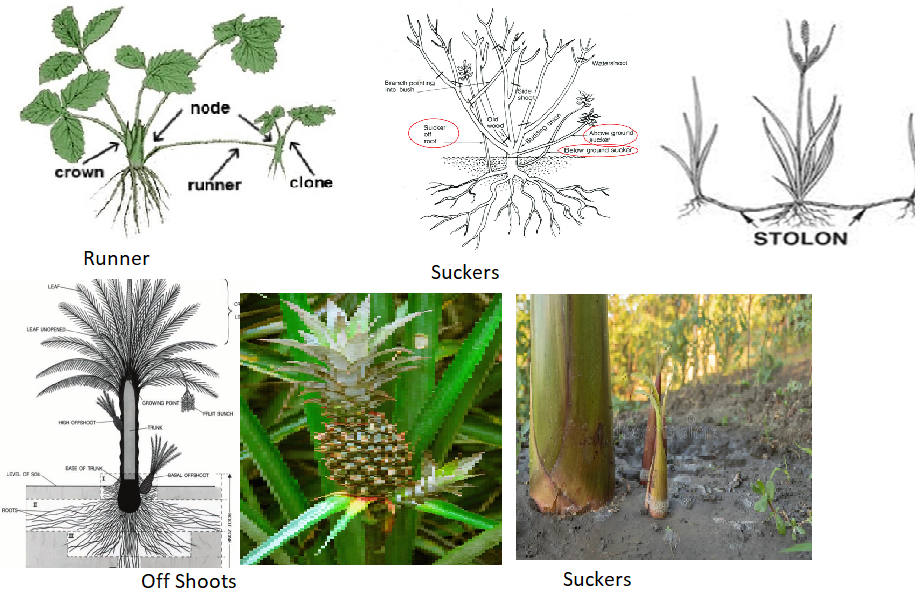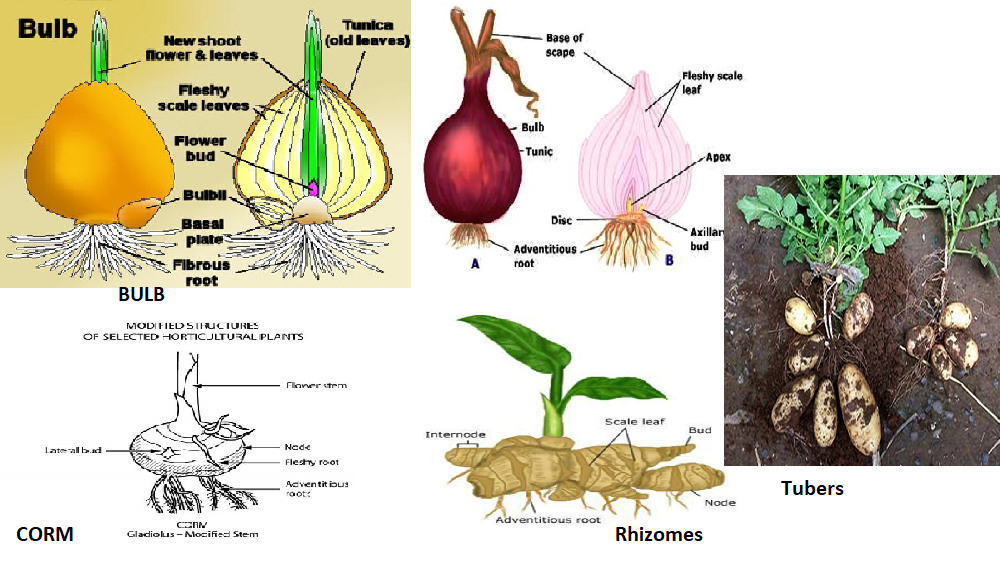Horticulture Guruji
Natural Modifications of Layering, Separations and Divisions
Natural Modifications of Layering
1. Runner
It is a specified tall slender stem that develops from the leaf axils at the crown of the plant, which prostate horizontally along the ground. Roots are visible in knots that come into contact with the soil. After root formation in the new plant, contact with the parent plant is automatically detached and the new plant can be detached and planted. Strawberry is a typical runner. Oxalis corniculata, Bosten fern, bugle (Ajuga), and spider plant (Chlorophytum comosum) are other examples of plants propagated through runners.
Watch Lecture Video
2. Suckers:
A sucker is a shoot, which grows from below ground, arising from an adventitious bud on a root. A plant’s ability to produce suckers varies from species to species and even from variety to variety. The branch visible from the root stem below the union of the bud and the graft is also called a sucker. Pineapple is usually propagated through suckers. Bananas produce two types of suckers, water suckers, and sword suckers. Suckers are separated from the mother plant and planted in nurseries or directly into the field. Apple clonal rootstocks are also multiplied by suckers.
3. Stolon :
It is a modified stem that grows horizontally on the ground above the soil surface. Stolons are found in Bermuda grass (Cynodon dactylon), mint (Mentha sp.), they are used to grow new plants after separating them from the parent plant.
4. Off-sets (off-shoots):
An offshoot is a young plant that is later produced by the parent plant or branch that in some plants develops from the base of the main stem, which can be easily detached. The term offset is commonly used for the short, thick stem that looks like a rosette. The term is also used for the lateral branches arising on the stems of monocotyledonous fruit plants, such as dates, pineapples, or bananas. For propagation, well-rooted offsets are cut close to the main stem with a sharp knife and planted in a suitable medium or soil.

Separations and Divisions
1. Bulb:
A bulb is a complex structure, consisting of a short, thick stem and roots on the lower side and thick fleshy leaves on the upper side. Bulbs are usually produced by monocotyledonous plants in which they are modified to store food and water and reproductive organs. oxalis, is a dicot species that produce bulbs. Bulbs usually have bulb scales. The outer bulb scales are fleshy, in which food material is stored, while the inner scales do not function as storage organs and are leaf-like. In the center of the bulb, there is either a vegetative meristem or an unopened flowering shoot. The meristem develops into the axis of these scales to produce small bulbs, known as bulblets, which are known as offsets when they grow to full size. In some species (such as lilies), bulblets are produced in underground organs. There are two types of bulbs i.e. tunicate (laminate) and nontunicate (scaly).
i. Tunicate (laminate) bulbs: Examples of tunicate bulbs are onions, garlic, daffodils, and tulips. These bulbs have outer bulbous scales which are dry and membranous. This cover or tunic provides protection against drying out and mechanical damage to the bulb.
ii. Non-tunicate (scaly) bulbs: Non-tunicate bulbs are found in lilies, have dry scales, and are loosely arranged like flower petals covering each other. In general, non-tunicate bulbs are easily damaged and should be handled with more care. They must be kept moist as they tend to get injured by drying out.
2. Tubers:
A tuber is a swollen, modified underground stem, which primarily serves as the storage organ of the plant. Potatoes, caladiums, yams, Jerusalem artichoke are examples of tubers. Tubers consist of nodes (eyes), internodes, lateral and terminal buds. The eyes (nodes) of a tuber are spirally arranged, containing one or more small buds. Typically, one bud in the eye sprouts and suppresses the growth of the others, indicating the phenomenon of apical dominance. Usually, removing the shoots before the stem allows other buds to sprout. Propagation by tubers is usually done either by planting the entire tuber or by cutting the entire tuber into pieces, a process called division.
3. Rhizome:
A rhizome is a modified and specialized stem structure in which the main axis of the plant grows horizontally at or just below the soil surface. The rhizome is segmented consisting of nodes and internodes. A leaf-like covering is attached to each node, which on extension becomes the foliage. Usually, roots develop in the vicinity of the nodes. Flowering stems, called culms, arise either from the rhizome tip or from lateral branches. The banana is a typical example of a rhizome. Other rhizome plants are ginger, bamboo, iris, sugarcane, and many types of grasses.

4. Corm:
A corm is a short, solid, highly inflated underground stem surrounded by dry scales like leaves, with one or several buds on top, a tuft of leaves on the upper side, and a base surrounded by a ring of thick fibrous roots. At the top of the corm is the terminal shoot, which usually develops into a flowering branch or leaves. Gladiolus, crocus, and water chestnut are some examples of typical corms plants. Corm plants can be propagated through new corms, cormels, or corm segments. Typically, a mother corm produces 2-3 new corms and 15-20 cormlets or miniature corms.
5. Tuberous Roots:-
These are thick tuberous growths that act as storage organs. Tuber’s roots are present in sweet potato, cassava, dahlia, etc.
References cited
1.Chadha, K.L. Handbook of Horticulture (2002) ICAR, NewDelhi
2.Jitendra Singh Basic Horticulture (2011) Kalyani Publications, New Delhi
3.K.V.Peter Basics Horticulture (2009) New India Publishing Agency
4. Jitendra Singh Fundamentals of Horticulture, Kalyani Publications, New Delhi
